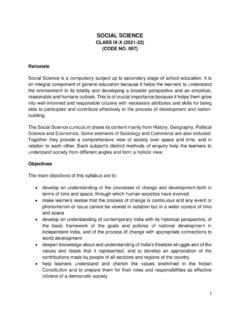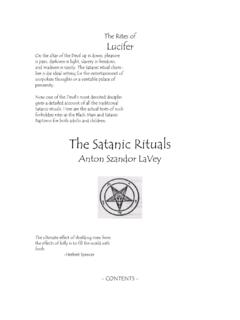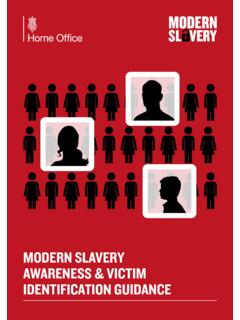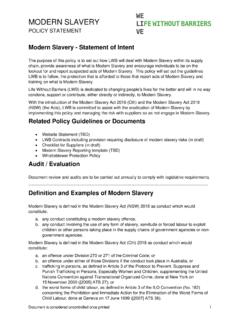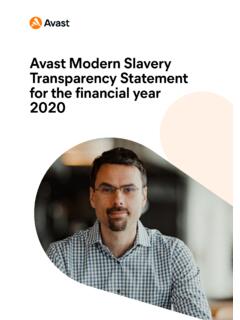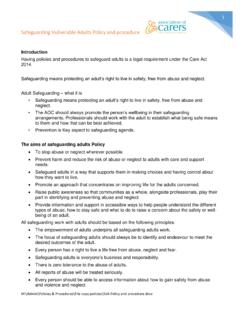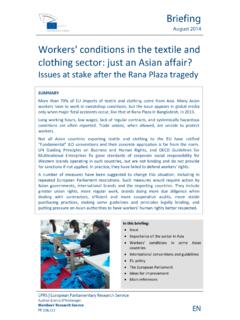Transcription of A Typology of Modern Slavery - GOV.UK
1 A Typology of Modern Slavery Offences in the UKResearch Report 93 Christine Cooper, Olivia Hesketh, Nicola Ellis, Adam Fair Home Office Analysis and InsightOctober 2017iiA Typology of Modern Slavery Offences in the UKContentsAcknowledgements iExecutive summary iiAim and approach iiFindings iiDiscussion and next steps vi1. Introduction 1 Geographical scope of the report 1 The Crime of Modern Slavery 2 Modern Slavery in the UK 3 Origins of the Typology 42. Methodology 6 Aims and approach 6 Other typologies 6 Data sources 7 Data limitations 83. Findings 9 Introduction 9 The dimensions 9 The types of Modern Slavery 10 The Typology of 17 types of Modern Slavery offences in the UK 11 The profiles 124.
2 Conclusions 47 Next steps 47 Annex 1 Methodology 49 Data sources 49 Limitations 50 Analysis 51 The database 51 Annex 2 Coding framework 56 AcknowledgementsThank you to the following individuals and groups with whom we consulted when developing the Typology : Human Trafficking Team and Directorate for Children and Families, Scottish Government; Department of Justice, Northern Ireland Executive; Wales Anti Slavery Co Ordinator; Joint Slavery and Trafficking Analysis Centre (JSTAC) intelligence analysts representing the National Crime Agency, National Policing, Border Force, Immigration Enforcement and Gangmasters and Labour Abuse Authority; National Police Chief s Council Lead for Modern Slavery , Chief Constable Shaun Sawyer; Modern Slavery Police Transformation Unit Insight Team; National Human Trafficking Unit, Police Scotland; Police Service of Northern Ireland; National Crime Agency (NCA); Home Office Modern Slavery Unit; Home Office Safeguarding Unit; Crown Prosecution Service; Professor Bernard Silverman, University of Oxford; Professor David Gadd, University of Manchester.
3 Dr Rosemary Broad, University of Manchester; Kevin Hyland, Independent Anti Slavery Commissioner; Dr Claire Brickell, Office of the Independent Anti Slavery Commissioner; Dr Sasha Jesperson, St Mary s University Centre for the Study of Modern Slavery ; Danielle Williams Academics and practitioners at the St Mary s Centre for the Study of Modern Slavery inaugural international conference (8 10 February, 2017); Police and analysts in the South West region and West Midlands police forces; The Salvation Army; The Child Sexual Abuse (CSA) Centre of Expertise; The Children s Task and Finish Group including representatives from ECPAT UK, the National Society for the Prevention of Cruelty to Children (NSPCC), The Children s Society, Barnardo s, UNICEF UK, Afruca, The Children s Commissioner for England, and the Local Government Association; The Joint Money Laundering Intelligence Taskforce (JMLIT) Expert Working Group on Modern Slavery ; Polaris, USA anti trafficking hotline; and Unseen, UK Modern Slavery Typology of Modern Slavery Offences in the UKiiA Typology of Modern Slavery Offences in the UKExecutive summaryThis report presents findings from research to create an evidence based Typology of Modern Slavery offences in the UK.
4 Modern Slavery is an umbrella term that encompasses the offences of human trafficking and Slavery , servitude, forced or compulsory labour, as set out in the different anti Slavery legislation in place in the four UK countries (England, Wales, Scotland and Northern Ireland). Modern Slavery frequently involves multiple victims, offenders and places, and it is often hidden and involves or takes place alongside a wide range of abuses and other criminal offences. The Home Office estimated there were 10,000 13,000 potential victims of Modern Slavery in the UK in 2013. Aim and approachThis research sought to devise a Typology of Modern Slavery offences to improve our understanding of the different ways that Modern Slavery manifests in the UK and to inform tailored policy and operational responses.
5 The Typology is based on analysis of detailed data on 328 confirmed cases of Modern Slavery in the UK. As Modern Slavery is often a hidden crime, these data sources are partial and only cover Modern Slavery that has come to the attention of the authorities. However, this approach was considered appropriate given the exploratory nature of this research. The Typology was refined through consultation with experts including the Joint Slavery and Trafficking Analysis Centre, academics, non governmental organisations (NGOs) and frontline staff such as police Typology identified 17 types of Modern Slavery offences in the UK (see figure below). It sets out the characteristics of the victims, offenders and offences involved for each type.
6 In particular we looked for how members of law enforcement, other statutory agencies, NGOs and communities may recognise the exploitation and tackle the different manifestations of the crime. Some cases of Modern Slavery may span multiple types in the Typology . This research did not estimate the prevalence of each type of Modern Typology of Modern Slavery Offences in the UKLabour exploitation1 Victims exploited for multiple purposes in isolated environmentsVictims who are often highly vulnerable are exploited for labour in multiple ways in isolated rural locations. Victims live on offenders' property in squalid conditions, are subject to repeated abuse and are very rarely Victims work for offendersVictims are forced to work directly for offenders in businesses or sites that they own or control (some offenders may be gangmasters).
7 The main method of exploitation is not paying or illegally underpaying Victims work for someone other than offendersVictims are employed in a legitimate and often low skilled job, with legal working conditions, by an employer unrelated to the offenders. Most or all wages are taken by offenders often through control of the victims' bank servitude4 Exploited by partnerVictims are forced to undertake household chores for their partner and often their partner's relatives. If married, the marriage may have been arranged or forced and the servitude often occurs alongside domestic abuse and sexual Exploited by relativesVictims live with and exploited for household chores and childcare by family members, usually extended family.
8 Many victims are Exploiters not related to victimsVictims live with offenders who are often strangers. Victims are forced to undertake household chores and are mostly confined to the exploitation7 Child sexual exploitation group exploitationChildren are sexually exploited by groups of offenders. This is usually for personal gratification, but sometimes the exploitation involves forced sex work in fixed or changing locations and will include characteristics of types 9 and 10. Offenders frequently transport victims to different locations to abuse Child sexual exploitation single exploiterSimilar to type 7, often involves the grooming of children and transporting them for the purposes of sexual exploitation, although the offending is carried out by one Forced sex work in fixed locationVictims are trafficked and exploited in established locations set up specifically for sex work.
9 This can include brothels or rooms in legitimate business premises ( massage parlour).10 Forced sex work in changing locationVictims are forced into sex work where the location of exploitation frequently changes. Locations include streets, clients' residence, hotels or 'pop up' brothels in short term rented property. Victims are frequently advertised Trafficking for personal gratificationVictims are trafficked to residential sites controlled by offenders and sexually exploited for the offenders' own gratification. Some victims may be confined to the site for a long period of Typology of 17 types of Modern Slavery offences in the UKivA Typology of Modern Slavery Offences in the UKCriminal exploitation12 Forced gang related criminalityVictims are forced to undertake gang related criminal activities, most commonly relating to drug networks.
10 Victims are often children who are forced by gangs to transport drugs and money to and from urban areas to suburban areas and market and coastal Forced labour in illegal activitiesVictims are forced to provide labour to offenders for illegal purposes. The most common example is victims forced to cultivate cannabis in private Forced acquisitive crimeVictims are forced by offenders to carry out acquisitive crimes such as shoplifting and pickpocketing. Offenders may provide food and accommodation to victims but rarely pay Forced beggingVictims are transported by offenders to locations to beg on the streets for money, which is then taken by offenders. Victims are often children vulnerable Trafficking for forced sham marriageTraffickers transport EU national victims to the UK and sell these victims to an exploiter in a one off transaction.










